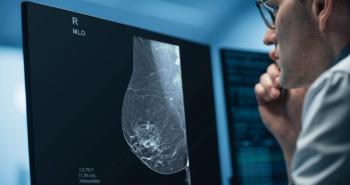
For Breaking News about Cancer Diagnoses, Patients Prefer Breast Imagers
Patients indicated breast imaging radiologists expressed more empathy over the diagnosis and had more understanding of their scans than other providers.
Breast imaging radiologists are in the best position to give patients bad news associated with their exams.
From the patient’s perspective, radiologists do the best job in delivering upsetting information, said Colleen McNally, a fourth-year medical student at Georgetown University School of Medicine. She presented her poster and the results of her survey during the Society of Breast Imaging/American College of Radiology 2021 Virtual Annual Meeting.
For more Society of Breast Imaging conference coverage, click
“The results of this survey show that breast imaging radiologists are in the best position to deliver bad news with regards to understanding the disease process timing, honesty, and empathy,” she said. “Breast imaging radiologists often deliver bad news to patients, such as the need for imaging work up and biopsy or discussing breast cancer results.”
Despite these results, she said, there is still a need for structured educational models designed to teach providers about “breaking bad news.” The overall goal should be improving communication skills, the patient’s experience, and ultimately, bolstering their ability to cope with a cancer diagnosis.
For her study, McNally delivered a cross-sectional prospective survey via email to patients who had breast cancer diagnosed by image-guided biopsy between May 1, 2019, and April 30, 2020. She asked about the type of provider who delivered the news to the patient, the method of communication, the presence of trainees in the room, the time and day of the week, whether a warning shot was given prior to results, and personal preferences on who should deliver cancer news. In addition, she gathered details about patients age and demographics, as well as if the patient had access to a patient portal.
A total of 105 patients were surveyed, and 43 (40 percent) responded. Of that group, 21 patients (49 percent) received their cancer diagnosis from the procedure radiologist (15 via telephone and six in person), and 21 others (49 percent) were told by other specialists. Only one patient found out via the patient portal.
Based on her analysis, radiologists performed well – 85 percent of respondents said the radiologist was completely honest and did provide a warning shot.
“[These] respondents felt the radiologist was empathetic and considerate of their feelings during [the] delivery of cancer diagnosis,” she said.
In fact, 54 percent said a radiologist was their preference because not only did imagers have had good communication skills and a greater understanding of their imaging, but they also provided results faster. Still, 46 percent of patients did prefer to hear the news from their own physician, mainly because of a long-term existing relationship.
Newsletter
Stay at the forefront of radiology with the Diagnostic Imaging newsletter, delivering the latest news, clinical insights, and imaging advancements for today’s radiologists.



























